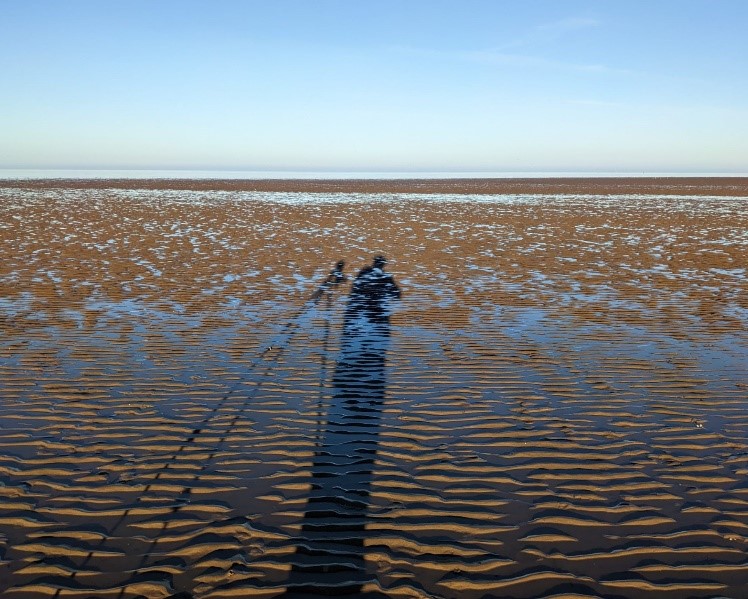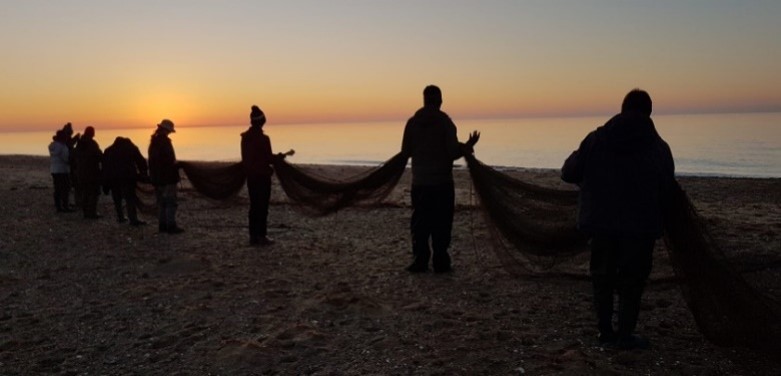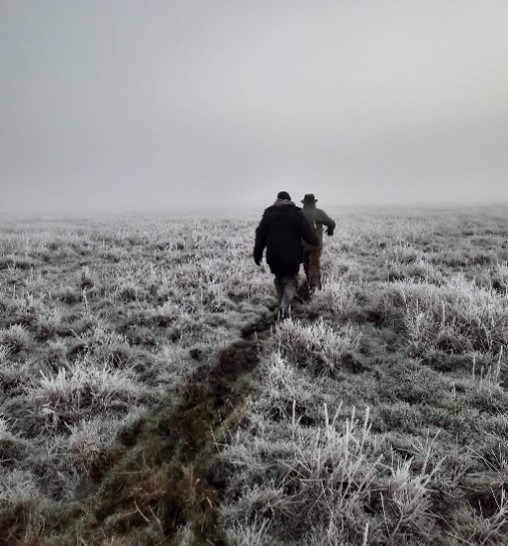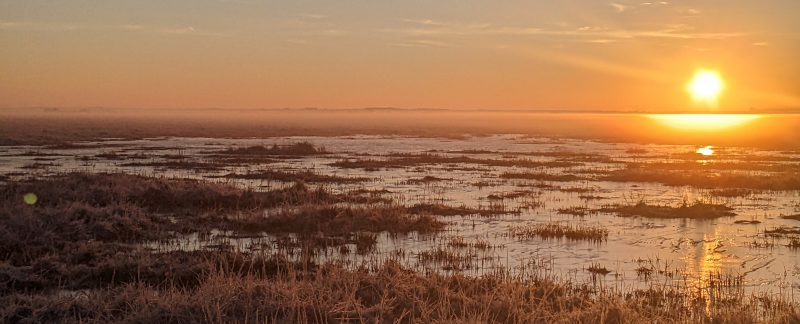Friday 20 January
At 13:00 Mark went to recce on Heacham South beach. At this time the tide had a long way to come back in and there were lots of Oystercatchers out on the mud. Strong onshore wind and waves caused the birds to come quickly off the mud and onto the beach. Mark observed five separate groups of about 100 each. Some of the birds moved right up to the previous tide line before high tide arrived while three of the groups stayed at the water’s edge. Unhappy with the large amount of people and dog walkers on the beach, many birds flew off to Snettisham Pits; however, Mark stayed until after dark (around 16:30), by which point the number of people had reduced, and despite the strong wind there were still Oystercatchers on the grot line.
Cathy, Flo, Jade and David N. arrived at the base mid-afternoon and began preparing an evening meal for the team. The rest of the group joining the team that day came in gradually throughout the evening. After Mark’s recce, the aim was to cannon net Oystercatchers at Heacham South on Saturday afternoon, and so after dinner Lucy led a team briefing about this upcoming catch. We could not cannon net on the Saturday morning as high tide was in darkness, so we spent Saturday morning resighting, a vital part of WWRG’s research. Rob P. discussed with us the best options for resighting.

Saturday 21 January
At around 07:15 groups headed off to resight. Mark and David K. dedicated the morning to going out onto Terrington Marsh (the probable site of mist netting on Sunday morning) to explore the outer pool and place markers for net positioning. Lucy prepared the kit ready for catching in the afternoon.
Cathy and Flo went to Heacham North North and on the falling tide resighted seven Curlew, one Bar-tailed Godwit and one Oystercatcher. Unfortunately, no Turnstone with colour-marks were seen.
Rob Rob visited Heacham North, stopping to check for Curlew at the Heacham high tide roost. On the falling tide intertidal, seven Bar-tailed Godwit and eight Curlew were seen. This included one ‘control’ sighting of yellow flag ‘NHZ’, a bird originally flagged in Norway on migration to The Wash and regularly seen wintering locally.
Rob P took three cars of observers to Snettisham Pits. There were delays in everyone arriving and promptly exiting cars, meaning the intertidal had already begun to uncover. David N, Liam and Jade were dispatched to try and assess how many birds were roosting at high tide at the Pits. By the time they arrived, around 60 birds were present, but soon dispersed. Tony and Leigh went for the North end of Snettisham Beach around the south end of the dam, and saw a quartet of WWRG-flagged birds: Oystercatcher (one of the satellite-tagged birds), Bar-tailed Godwit, Curlew and Grey Plover. The Grey Plover (E6) is the most frequently re-encountered Grey Plover on our database, having been seen 14 times since flagging. We tend to re-encounter a small number of the same Grey Plover on defined wintering territories, which may be a future avenue to investigate this under-reported wader. Rob P, Lewis and Alice found a Bar-tailed Godwit flock on arrival and resighted four Curlew and three Bar-tailed Godwit.
After the window for seeing birds on the intertidal closed at around 09:40, Dave N’s group relocated to Heacham NN to help search for Turnstone. Tony and Leigh visited Snettisham Rec ground to investigate a flock spotted on social media and were rewarded with three flagged Curlew. Rob P’s car went on a mission to find Curlew in fields at low tide. We know Curlew frequently use fields to feed in at high tide during winter, and we know that some stay to feed at low tide, though fewer in number. The first stop was to read flags of two Curlew in the field opposite the RSPB reserve (which David N’s team had frustratingly been watching for 10 minutes without the flags being in a readable position). A total of 23 fields in five location clusters were checked, with a total of two fields containing Curlew found. We found that multiple car occupants can allow a surprising number of locations to be checked in an hour (and should be considered a regular part of fieldwork sessions). The teams then congregated at Heacham South café (closed for the winter, much to the annoyance of Rob R) to join the rest of the group for setting. We have now reached 80 individual Curlew encountered this winter, which allows us to perform year-on-year survival analysis of our wintering population. Our Bar-tailed Godwit data is less robust, with 20 individuals seen this winter (however we added eight individuals from this weekend’s fieldwork).
Resighting totals for session
| Species | Encounters | Total individuals |
| Bar-tailed Godwit | 12 | 10 |
| Curlew | 34 | 21 |
| Grey Plover | 1 | 1 |
| Oystercatcher | 1 | 1 |
| Bar-tailed Godwit marked elsewhere | 2 | 1 |
| Total | 50 | 34 |
At 11:30, the whole team grouped together at Heacham South and, with Nigel, Jacquie, David H., Skye and Kirsty who had just joined us, set to work setting two cannon nets on the beach in two teams. Both were full large-mesh nets and they were set on full jumps. One was set low on the beach as we normally do on this site, while the other was set higher up the beach where the birds had roosted on the previous day. Grot (camouflage for the furled net consisting, on this site, of seaweed) was extended beyond the net to give the impression of a lower tide line. We focussed our first attempt on the lower net, hoping for a rising-tide catch and using the higher net as a backup in case the Oystercatchers went immediately straight up the beach or we were unsuccessful with the rother net. In stark contrast to the day before, there was not a single breath of wind nor a ripple in the sea. Due to this, it was predicted that the net would go out very well.
While the majority of the team had a picnic behind the dunes, Tony, Jade and Flo stayed on the beach to watch over the nets, engaging with members of the public to tell them about the upcoming catch (guiding them away from the sets) and explain a little about the research the group undertakes on The Wash. In the distance, far out over the sea, several huge flocks of waders swirled and twisted in long flashing streamers.
Just after 14.00, Lucy and Cathy got into position – with the firing box – on the beach for the lower net, while Mark was positioned near to the higher net. Basecamp hunkered behind the dunes and Kirsty and Nicholas long stopped.

While the tide was still far out, waders gathered along the water’s edge and some gathered just down from the decoys, beyond the catching area. Lucy had to wait for the tide to push the Oystercatchers further up and we made a catch at 15:40.
Basecamp swiftly ran out into the sea and quickly and effectively lifted the net onto covering material and then covered the catch. Birds were extracted by experienced members then ferried in boxes to keeping cages behind the dunes. Good fun was had taking the nets off the beach once all birds were extracted: one of the net bags had split and so the net had to be carried in a long line, conga-style, in a hammock of covering material.
While Nigel and Lucy led separate processing teams Nicholas led the ringing team and all the team members joining the group (and ringing waders) for the first time were taught how to ring and age the Oystercatchers. It was interesting to observe the differently shaped Oystercatcher bills, some having a pointed end for stabbing, others having a square flattened end for hammering or prising open molluscs. One Bar-tailed Godwit was caught and was colour marked.
Ringing and processing finished around 18.30 and with all birds released we headed back to the base for a cooked breakfast for dinner!
After this we had a team talk to discuss the plan for mist-netting in the morning, when forecast was for very cold weather and fog. Mark volunteered to sleep by the marsh in his camper and check the weather in the morning. The trailer was swiftly packed with all the equipment for net setting and catching and we rushed to bed to get as much sleep as possible before the early morning start.
| Species | New | Retrap | Total |
| Oystercatcher | 65 | 32 | 97 |
| Bar-tailed Godwit | 1 | 0 | 1 |
| Totals | 66 | 32 | 98 |
Sunday 22 January
At 03:00 the whole team began getting ready to leave as Mark had phoned to give us the all clear. Arriving at Terrington Marsh at 03:45, 11 of the team trekked out over the frozen expanse to set nets on the Outer Pool, attaching lights to marker poles along the way, and Michele, Lucy, David K. and Cathy set up base camp at the barn, including getting keeping cages ready for the birds.
Just four nets were set on the crystalised saltmarsh, mainly due to the challenging weather conditions. The Outer Pool had a hard, frozen surface and the temperature was dropping. On arriving at the pool, an incredible rush of thousands of wings was heard not too far away as a colossal flock lifted off. This was later thought most likely to have been Bar-tailed Godwits, further evidence being the large amount of guano seen on the ice. Once the nets were up and a tape lure switched on, the catching team waited in the darkness a distance away from the nets to allow the birds to settle. With our torches switched off to improve night vision and limit disturbance to the waders, we could see a beautiful starry sky above us, encircled by gradually thickening fog.
In total, three rounds of the nets to extract birds were undertaken. The rate of catching was very low; however, this gave inexperienced members a really good opportunity to extract waders from mist nets in the dark. Nicholas, Liam and Flo carried the birds off the marsh and it was noted that the new design of large bird bag was easy to use and felt more secure than the traditional hessian sacks. While the birds were put into keeping cages back at the barn, the rest of the marsh team took down the nets, a decision being made (after a blank net round) that few or no more birds would be caught as the thickening fog started to freeze on the nets making them very obvious.

Once the whole team was back at the barn, we ringed and processed the birds. The cattle were in the other half of the barn and the comforting sound of their lowing was the backdrop to our discussions of measurements, ring numbers and ages. The three Knot caught were colour ringed and flagged, Lucy teaching Flo and Nicholas to do this for the first time.
| Species | New | Retrap | Total |
| Knot | 2 | 1 | 3 |
| Dunlin | 8 | 0 | 8 |
| Black-tailed Godwit | 1 | 0 | 1 |
| Bar-tailed Godwit | 3 | 0 | 3 |
| Redshank | 5 | 0 | 5 |
| Totals | 19 | 1 | 20 |
We returned to the base house to warm up and enjoy some breakfast, then Mark led a catch debrief and explained the list of various jobs which needed to be done before departure for home. A large part of this included disinfecting all equipment, such as hessian material, keeping boxes and cages, and mist nets as part of our HPAI protocols; during ringing and processing we minimise the mixing of birds to further reduce the transmission of any HPAI in case it is present asymptomatically. Once everything was hung to dry, catching data was sorted, resightings submitted to the Shiny App and the house tidied, most people began to head home.
Mark, Rob R, Cathy and Flo stayed and in the evening took a walk across the sea wall overlooking fenlands extending from Peter Scott’s Lighthouse. In addition to a magical sunset, highlights included several hunting Barn Owls, Little Grebes in the creeks, the odd Redshank, a large flock of Pink-footed Geese, Curlew and Lapwing.
| Species | New | Retrap | Total |
| Oystercatcher | 65 | 32 | 97 |
| Knot | 2 | 1 | 3 |
| Dunlin | 8 | 0 | 8 |
| Black-tailed Godwit | 1 | 0 | 1 |
| Bar-tailed Godwit | 4 | 0 | 4 |
| Redshank | 5 | 0 | 5 |
| Totals | 85 | 33 | 118 |
Thank you to Lucy and Mark for being such brilliant leaders this weekend and to all the other experienced members who put in a super effort to help introduce the new team members to this extraordinary wader research.
Thanks to Flo Turner for writing this report.

